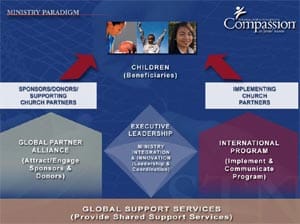So to follow up on the clock analogy, what makes Compassion tick? Which gears and teeth make Compassion run and how?
Are there letter-writing genies in the basement? Does Compassion’s headquarters even have a basement?
Do Santa’s workshop personnel kick it here during the off-season addressing and licking envelopes and sleighing over to Togo, Indonesia and Honduras to drop off sponsor letters? Payroll and finance must have a tough time keeping up with the influx of elfishness.
No genies. No basement (that I’m aware of). No elves. No sleigh. (Although there may or may not be a task force looking into the cost benefit analysis of said magical sleigh. Postage is expensive.)
Today, I will break this down into a very high level overview. It won’t be totally satisfying but one must start somewhere. We can get into the nitty gritty later.
First the Ministry Paradigm. Or rather, my version of it.
 Before you tune out, the Ministry Paradigm is basically a high-level representation of how Compassion is organized to best serve children.
Before you tune out, the Ministry Paradigm is basically a high-level representation of how Compassion is organized to best serve children.
And when you think about it, every organization should have a specific goal: mainly to take the mission and vision, devise a strategy to implement change, employ specific operations to reach the desired outcomes, and measure them along the way to gauge impact. Right?
I think we can all agree that the children are the main focus of Compassion’s work. The children are the reason you sponsor, and it is you who allow us to serve them.
Now, we’ve got two sides of the equation. Two main feeders serving Compassion’s children — church partners in the field and sponsors here in the U.S. (and abroad). A gross misrepresentation, but go with this analogy: hands and money.
First, the hands.
Implementing church partners are those churches on the ground in developing countries that host the child programs. They provide services to children ranging from spiritual education to meals to health checkups and more.
How do they do this? With a lot of help. Undergirding all implementing church partners is an entity called International Program.
International Program’s main function is to implement and communicate programs. There are four programs that holistically serve children from infancy, potentially through college: Child Survival, Child Sponsorship, Leadership Development and Complementary Interventions (CIV).
The diagram below may look familiar to you.

The indiscernible numbers along the bottom represent the ages of children as they move through Compassion’s programs. The red line moving through the model represents Complementary Interventions that complete the core programming as needed.
Disaster relief, water projects, infrastructure development and income-generating activities all affect the environment in which children live.
Interventions relating to AIDS, malaria or education are activities that supplement development outcomes of children. These are CIV.
We talked about the hands — now, the money.
If you look back up at the Ministry Paradigm diagram, you’ll find sponsors, donors and supporting church partners play a crucial role in supporting children. Without these key players there would be no Compassion.
So, if you sponsor a kid, that’s you. You in Missouri, you in Canada, you in the U.K.
The Global Partner Alliance is the main body supporting sponsors, donors and supporting church partners. Its main function is to attract and engage sponsors and donors.
The Global Partner Alliance is made up of the 10 partner countries that fall voluntarily under the Compassion International umbrella. That is Compassion U.K., Australia, Korea, Switzerland, Italy, etc.
So, what drives the relationship between the hands and the money? How do you ensure that what’s happening in Togo is the same thing that’s happening in Guatemala, and that Compassion Deutschland is on the same page as Compassion Korea?
Good question. It’s the executive leadership of Compassion International, housed here at the Global Ministry Center in Colorado Springs.
They provide leadership and coordination at the highest level. They are the go-between for International Program and Global Partner Alliance, ensuring long-term integrity of operations and communications. No small feat for an organization of more than 2,000 workers serving more than 1 million sponsored children in 25 countries.
Undergirding it all is Global Support Services. Its main mission is self-explanatory but worth repeating: to provide shared support services across the greater ministry of Compassion International.
That, in its most basic form is the big picture — a high-level look at how Compassion is structured to carry out its mission of releasing children from poverty in Jesus’ name.
Tune in soon for a breakdown of life and structure here at Compassion International in Colorado Springs — the Global Ministry Center. We’ll take a deeper dive into Global Support Services.







6 Comments |Add a comment
Well one Lauren! You made it soooooo easy to understand!
You’re very good at breaking down systems and explaining them. This really helps to understand a little bit more of how such a corporation works.
I’m pumped to hear the next few reports, keep them coming.
Thanks Lauren; that was very interesting and informative. You keep writing and I’ll keep reading. 🙂
Thank you, I sponsor b/c of Jesus not the kids. Jesus is the only reason I was able to save enough money to visit some of the kids I sponsor. And sharing and encouraging Jesus is the only reason I believe in sponsoring. The kids are precious and priceless and created in God’s image and Jesus lives in many of their hearts, but for me it’s Jesus empowering me to sponsor and visit and to believe in the difference HE is making. Philippians 1:6 “He who began a good work in you will be faithful to complete it until the day of Christ Jesus.” If God can do this in me, He can do it in the kids I sponsor, that is why I sponsor b/c of the work Jesus is doing in the lives of the kids, not the kids. It is almost one in the same, but not quite to me. Also I want them to realize they are not the reason I sponsor, Jesus is the reason I sponsor! Jesus is the only one who will always be there for me even after I die 😉 I think that is what is so great about Jesus once you have Him it’s impossible to lose Him and He doesn’t run out. “Give someone a fish, feed him for a day.”
“Give someone Jesus and you’ve given him eternal life!!!!!!!” My sponsorship at some point will run out but what will not I believe is the encouragement and strength the kid’s received from God’s Word.
OUCH… let me help you 🙂 “hands and heart“
A system that works 🙂